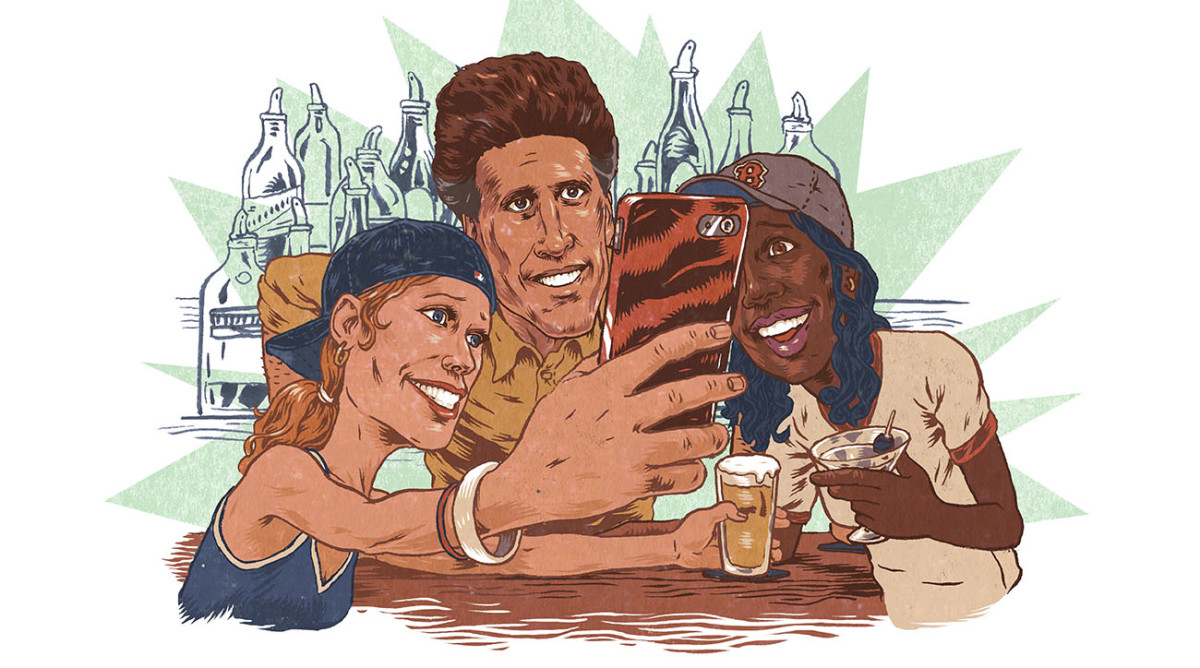How the World Has Changed in the 25 Years Since the Final Cheers Episode

A guy walks into a bar.
The guy is bombastic Yankees slugger Dutch Kincaid, and the bar is Cheers, at 112½ Beacon Street in Boston. "I'm looking for a yellow-bellied, runny-nosed has-been," barks Kincaid. To which the bartender, Woody Boyd, replies, "I can't make one of those—I'm out of cassis."
Kincaid was really looking for Sam Malone, who bought Cheers with the meager life savings he had socked away during seven substandard seasons in the Red Sox bullpen. Twenty-five years have passed since anyone last saw the man they called Mayday behind that bar at Cheers, where he handed beer nuts to beer nuts—mailmen, shrinks and CPAs—from 1982 to 1993.
And while Cheers is still there, just downstairs from what was Melville's Fine Sea Food restaurant, the world around it has changed beyond recognition in the past quarter century. Every bartender is now a mixologist, serving artisanal cocktails (heavy on cassis) to anyone thirsting for a Runny-Nosed Has-Been.
Where once there were two kinds of beer—regular and "lite"—there are now hundreds. There was no Internet the last time we saw Sam Malone. ("Wouldn't you like to get away?" went the theme song to a popular TV show in the 1980s, a decade when you really could do just that.) Almost nobody had a cellphone. There was no Google. If you wanted to summon dubious "facts" in an instant, you consulted, at your peril, the blowhard postman and Cheers regular Cliff Clavin, who preceded half his sentences with: "Little known fact...."

Imagine those regulars now, 25 years older than they were in middle age, mocking the modern baseball lingo (WAR, launch angle, exit velo) blaring from the lone TV above the bar.
Cliff: What was your WAR, Sammy?
Norm: The War of 1812.
Pitch counts? Baseball had body counts in Sam's day. On June 13, 1974, Nolan Ryan threw 235 pitches in a game against Malone's Red Sox. Even in relief, Mayday would pitch until his arm fell off. He once surrendered back-to-back-to-back-to-back home runs, the equivalent of striking out four times in a game. That act of incompetence, once known as a Golden Sombrero, might now be the name of a craft beer or an NSFW entry on Urban Dictionary, as obscure baseball traditions—games of pepper, sanitary socks, sacrifice bunts—disappear along with the decades.
In Mayday's heyday, in the age before Twitter, his legend accrued the old-fashioned way—by word of mouth. Everyone knew his name, out of proportion to any achievements in his short and self-immolating days as a pitcher. When a French patron recognized him at the bar, Sam asked the guy if he followed baseball. "No," explained the Frenchman. "Stewardesses."
They're flight attendants now, of course, but the point remains: Malone was a womanizer. He broke more hearts than bats in the 1970s, and had his broken in turn. Before the iPhone, his contacts were a black book housed in a waterproof pouch stored in a wall safe in his Cheers office. He had many friends, some of them famous athletes (Celtics power forward Kevin McHale) and some less famous athletes (the Bruins netminder Eddie LeBec, killed in a freak Zamboni accident while performing as an ice-show penguin). And it must be said that a great many of his friends were women.
Some of those were ex-girlfriends and one-night stands. Malone once claimed to have been with "400 women, easy." To which Cheers employee Diane Chambers replied: "They'd have to be." If the line sounds retrograde to 21st-century ears, remember that this was decades ago, before Netflix, when a single episode of a network TV show could be watched by more than 80 million people. (Such was the case with the final episode of Cheers, airing 25 years ago this month, on May 20, 1993.)
Sam Malone is 70 now. What is he up to? After all, there are as many ways to be a 70-year-old ex-jock as there are to be human. His contemporaries, born in 1947, are on Dancing with the Stars (Kareem Abdul-Jabbar), recently paroled after nine years in a Nevada prison (O.J. Simpson) and celebrated as the winningest Division I basketball coach in NCAA history (Mike Krzyzewski). Pete Maravich would be 70 now but died young, at age 40. Seventy is a milestone, the biblical age of threescore and 10, when a man has, in Mark Twain's words, reached his "scriptural statute of limitations." Seventy is a time of reckoning. The Yankees fired Casey Stengel as their manager at that age. ("I'll never make the mistake of being 70 again," Stengel said.)
Whatever else he's doing, we can be confident that Sam Malone isn't smoking. Though a cigar-store Indian greeted customers just inside the door at Cheers, the last time anyone saw Sam—in the closing seconds of that final episode—he was throwing an unlit cigar into the trash can behind the bar. He couldn't stand cigars.
Of course, you can no longer smoke in bars, or anywhere else. Coach, the bar's elder statesman, died in 1985. Sam is now nine years older than Coach was then, still fit and vital at 70, with the athlete's easy grace. A recovering alcoholic, he has been sober for decades. And while he made at least one pass at sex addiction rehab, he also made at least one pass at a fellow patient there. (To the woman seated next to him in group therapy, Malone said, "So, do you like Chinese food?")
But he has also, surely, evolved. Malone has felt the pain of ruined relationships, and not just his own. When the umpire Doug Aducci walked into Cheers, Sam recalled a fateful two-strike pitch to Thurman Munson that Aducci had called a ball, years earlier, in 1975. Naturally, a chest-bumping argument ensued, Sam kicked popcorn all over the ump's shoes, and Aducci ran Malone out of his own bar. Only then did the ump quietly confess, "It may have been a strike. I was going through a divorce that year."
These moments remain forever alive on YouTube, so that Sam Malone can now be summoned by smartphone the way he was once summoned by rotary-dial bullpen phone. The baseball-capped bullpen cart that ferried Malone to the mound of dirt at Fenway—like a hearse to a freshly dug grave in Sam's case—is now on display in the park's concourse, a historic artifact. Sam is likewise a historic artifact, a relic. He was a guy who specialized in long relief, a category that scarcely exists in this era of bullpen specialists.
And so it's safe to assume he's still behind the bar at Cheers, specializing in short relief. Where else would Sam Malone go? You may recall he tried sportscasting, on local news in Boston, with disastrous results. One of his old customers, Dr. Frasier Crane, moved to Seattle and achieved renown as a call-in radio host, but Malone is a quintessential bartender, whose role—as they say in radio—is longtime listener. He has heard a million stories over the years, and most of them begin, as this one did, with "A guy walks into a bar."
Alas, the neighborhood bar, like baseball itself, has lost its place of cultural primacy. As an honorable American institution, the neighborhood bar has been stripped for its parts. Once the so-called "third place"—somewhere to go besides home or work—the bar was displaced by Starbucks. As the place to meet Mr. Right (or Mr. Right Now), it has been supplanted by dating apps. Even those looking to get a buzz near home might visit their marijuana dispensary, a whole new kind of neighborhood joint.
It's a triumph, then, that Cheers remains standing and that Sam Malone does too. After throwing away that cigar, 25 years ago, the last thing America heard him say was, "I'm the luckiest sonofabitch on Earth." It had an echo of Lou Gehrig (of the hated Yankees). But it also had an echo of It's a Wonderful Life, and George Bailey, whose abundance of friends prompted his kid brother to toast him as "the richest man in town."
So raise a mango-infused pale ale to Sam Malone, the richest man in Beantown. Behold the horndog millionaire. We shall not see his like again.
